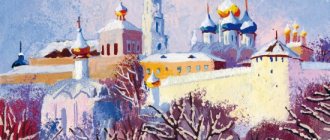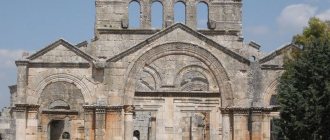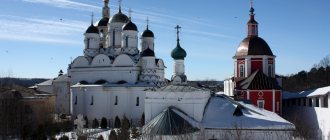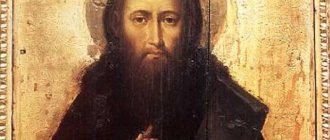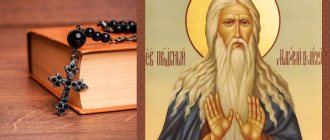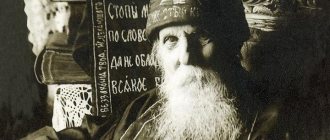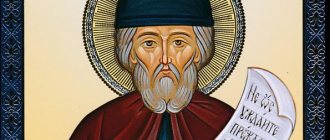| St. Alexander Oshevensky |
Alexander Oshevensky
(1427 - 1479), abbot, venerable Commemoration on April 20, in the Cathedrals of the Arkhangelsk and Karelian Saints
Born on March 17, 1427, 80 versts from Belozersk in the Vysheozersk volost.
In the world, Alexey, the fifth son of the rich farmer Nikifor Osheven and his wife Photinia, was a long-awaited child and was born through the fervent prayers of Photinia. The Mother of God herself, together with St. Kirill of Belozersky [1], appeared to her and promised the birth of a son at the intercession of St. Kirill. Although Alexey was the youngest son, his parents hoped to see him as an heir and their nurturer in old age. As a child, the boy was taught to read and write and trained to be an enterprising owner. At the age of 18 they tried to marry the young man. With the permission of his parents, he went to pray at the Kirillo-Belozersky Monastery and stayed there.
The abbot fell in love with the young man for his humility and soon invited him to take monastic vows. But Alexey refused, deciding to test himself. Studying the Holy Scriptures, he served the brethren as a novice for six years and only then took monastic vows.
By that time, his parents had moved to the village of Volosovo, 30 versts from Kargopol down the Onega River. Soon Nikifor asked the Novgorod boyar John for a place to settle near the Churyuga River, which was named Oshevenskaya Sloboda
.
The Monk Alexander asked the abbot for permission to accept the last blessing and forgiveness from his parents, so that he could then retire to a solitary life. The abbot did not immediately bless the young monk. He warned him about the dangers of desert living. But the Monk Alexander was afraid of the ascetic glory that he had among the brethren, and for the second time asked to be released from the monastery. Finally, the abbot blessed him.
Delighted by the meeting, the father invited his son to settle on the Churyuga River and promised to help in establishing the desert. The Monk Alexander liked the place. He planted a cross at the foundation of the future monastery and vowed to remain here until the end of his life. After that, the Monk Alexander returned to the Kirillo-Belozersky Monastery and for some time carried out obedience in the choir, in the cookery and in the bakery. He was ordained to the rank of deacon. Finally, when the Monk Alexander came to the abbot for the third time and told him how a wonderful voice had called him to the establishment of the monastery, how he had promised to stay in that place, the abbot released him, blessing him with the icons of the Mother of God Hodegetria and St. Nicholas the Wonderworker.
The Monk Alexander illuminated the chosen place with icons, instructed his father to oversee the construction of the church, and he himself went to Archbishop Jonah of Novgorod (1459-1470).
Archbishop Jonah ordained him to the rank of presbyter and made him abbot of the monastery. Boyarina Anastasia and her son Yuri were ready to give the entire volost to the monastery, but the Monk Alexander accepted letters only for the necessary lands. The built temple was consecrated in the name of St. Nicholas. With firmness and courage the monk began to work in the created monastery. The elder, who came with him from the Kirillo-Belozersky Monastery, could not stand the difficult desert life and went back. But little by little the brethren gathered. The monk introduced strict communal regulations, which required complete silence in the church and at meals when the lives were read; In the cell, the monks were not supposed to be idle, but while performing obedience, they were supposed to say the Jesus Prayer or read psalms. “Brethren,
” said the venerable abbot, “
let not the labors and sorrows of the desert frighten us.
You know that through sorrows you enter the Kingdom of Heaven. Let mutual love and humility live in you. God is love, and He loves the humble.” Many even from the laity came to the monk and took advantage of his instructions. Two of the saint’s nephews took monastic vows in his monastery, which angered one of the saint’s brothers, Ambrose. The Monk Alexander softened his brother with meekness, but his nephews lost interest in their zeal for their exploits and left the monastery. Sorrows for the salvation of spiritual children upset the health of the monk. He lay there and could not only raise his arm or head, but even utter a word. In such exhaustion, Saint Alexander prayed to Saint Cyril, his patron. The Monk Kirill appeared in white robes and, making the sign of the cross over the sick man, said: “Do not grieve, brother! I will pray and you will be healthy. Just don’t forget your vow, don’t leave this place. I will help you." Waking up, the monk felt healthy and the next morning he went to church. To reinforce the brethren, he told about the visit of St. Cyril. The monk worked for 27 years in the monastery he founded and died peacefully on April 20, 1479.
After the death of the abbot, the monastery began to quickly decline. But the monk did not leave care of her. One day, the monastery servant Mark had a vision in a dream: the monastery was full of people; a gray-haired old man in holy clothes makes the sign of a cross over the workers at the construction site. Another old man, with a long beard, sprinkles holy water, and a third, of medium height, with light brown hair, burns incense. The fourth, young, watches them from afar. The third elder, and this was the Venerable Alexander Oshevensky, explained that he was being helped by Saint Nicholas the Wonderworker and the Venerable Kirill of Belozersky, and the young man standing at a distance was the clerk Matthew, who was soon tonsured with the name Maxim and elected abbot of the monastery, as he had predicted in a vision Reverend Alexander. Monk Maxim was installed as abbot by Archbishop Sergius of Novgorod (1483-1485) and restored the monastery. He reigned until 1525.
During the construction of a new church in the name of St. Nicholas, at the direction of the appearance of the Monk Alexander, his incorruptible relics were found. At the same time, his image was painted according to how he appeared to the monks, and according to the story of the elder who knew him. The Monk Alexander Oshevensky was of medium height, with a dry face and sunken cheeks, with a small and thin beard, and graying in his light brown hair. In this form he is depicted on icons.
In 2022, his name was included in the list of the Cathedral of Saints of the Archangel Metropolis [2].
Life of St. Alexander Oshevensky
The Monk Alexander (in the world Alexey) was born on March 17, 1427 in the family of a wealthy peasant Nikifor Oshevny and Fotinia. At the age of 19, the young man went to the Kirillov Belozersky Monastery, where approx. In 1452 he took monastic vows with the name Alexander, and then the rank of priest. His father at that time moved “from the violence of earthly authorities” to the Churyega River, in the vicinity of Kargopol, where he invited his son to come. Alexander received the blessing of the Belozersk abbot Cassian to create a new monastery near the place of his family’s settlement and, together with a certain monk, came to Oshevenskaya Sloboda. Alexander received the blessing for the construction of the monastery and the rank of hegumen from Jonah, Archbishop of Novgorod. The construction of the monastery was overshadowed by a conflict between the monk Alexander and his brothers Ambrose and Lucian, whose sons, Peter and Nikon, were tonsured monks without their father’s blessing. Ambrose threatened to ruin the monastery and forcibly return his son to the family. As the Life tells, this conflict became the cause of Alexander’s illness, from which he was healed by the Monk Kirill of Belozersky, who appeared to him in a dream vision. Before his death, Abbot Alexander predicted difficult times ahead for the brethren. He reposed on April 20, 1479 and was initially buried on the right side of the wooden church of St. Nicholas that he built. Later, the relics of the Monk Alexander were hidden in the stone Assumption Church of the Oshevensky Monastery, where since 1707 a chapel was consecrated in the name of the saint.
Arkhangelsk diocese
Rev. Alexander Oshevensky
1427 – 1479
Memory – April 20/May 3
in the Cathedral of Karelian Saints – May 21/June 3
in the Cathedral of Novgorod Saints - 3rd Sunday after Pentecost
In the history of the development of northern monasticism, Saint Alexander of Osheven played a special role. The author of the “Arkhangelsk Patericon”, Archimandrite Nikodim (Kononov), says this: “For the Arkhangelsk region, the Venerable Alexander Oshevensky was in some respects the same as the Venerable Savvaty... His disciples spread the light of monastic life predominantly throughout the Arkhangelsk diocese” (2, 79 ). This saint is especially revered on the Kargopol land.
In the world, the Monk Alexander bore the name Alexy. He was born into a large and friendly family of wealthy peasants, eighty miles from Belozersk. Despite the fact that his parents, Nikifor and Photinia (or Svetlana) Oshevin, already had four sons (according to other sources - three sons and daughters (9, 260), they wanted to have one more. Nikifor especially wanted this. He even reproached his wife, who could not give him the desired son: “There is in you, woman, some kind of vice or sin!” (25, 576). The poor woman could only pray to the Mother of God for a miracle.
“The Lord is close to all who call on Him... He fulfills the desires of those who fear Him, He hears their cry and saves them” (Ps. 144: 18 - 19). Once, after a tearful prayer to the Queen of Heaven, Photinia dozed off. In a subtle dream, she saw the Mother of God, as well as a certain handsome, gray-haired old man. The Mother of God told her: “Your request will be fulfilled. And for the sake of this elder, the Lord will give you an eminent (i.e., famous) child who will glorify God and God will glorify him. This old man’s name is Kirill” (26, 228).
A year later, on March 17, the Oshevins had a long-awaited son, whom they named Alexy. This name means “man of God.” Perhaps the choice of name was due to the fact that this child was “a child begged from God.”
Since childhood, Alexy had an unusual character for a child. He was meek, friendly and quiet, and respected his elders; he avoided noisy games, laughter and entertainment, but loved to pray fervently at night; He fasted strictly on Wednesdays and Fridays, and was completely indifferent to the delicacies that children usually love very much. His usual food was bread, which he allowed himself to eat only once a day, and even then not to his fill.
At the age of seven, Alexy was sent to study reading and writing with a local sexton. The God-loving youth turned out to be a good student, since he comprehended book wisdom not with the hope of his own mind, but of God’s help.
Here is the prayer with which he addressed the Lord, asking him to help him in his teaching: “Lord Jesus Christ, the Only Begotten Son! Do not hide Your commandments from me, but give understanding to me, who seeks You, in everything, for You are blessed forever. Amen". With God's help, Alexy "quickly mastered book studies and gained skill in the Divine Scripture." His teacher, the sexton, did not know what to be more surprised at - the boy’s extraordinary talent or his ascetic inclinations. He saw in the youth Alexia the chosen one of God and humbly said: “He was given an understanding of books from God, and not from my teaching” (25, 578).
One day Photinia told Alexy about her vision before his birth, and also about who the elder was, through whose prayers he was born. This was the Monk Kirill Belozersky, Vologda miracle worker. The year of his death became the year of Alexy's birth. The monastery, founded by the Monk Kirill, stood sixty miles from the village where the Oshevin family lived. Of course, the mother’s words sank into the soul of the pious youth Alexy.
At the age of eighteen, Alexy decided to devote his life to serving God. He hid his desire from his parents, perhaps out of fear that his father, who was distinguished by his ardent disposition, would prevent his desire to go to the monastery. Therefore, when Alexy began to get ready for the Kirillo-Belozersky monastery, he told his parents that he wanted to go there on a pilgrimage.
Taking some bread with him and saying goodbye to his father and mother, he set off. Before this, he turned to God with the following prayer: “God, you commanded your servant Abraham: “come out from your land and from your kindred,” now teach me your fear. So I left my house for Your name's sake. Do not close the doors of Your Kingdom from me!” (25, 582).
Arriving at the monastery, Alexy revealed to its abbot his desire to become a monk and asked to be accepted as a novice. After a conversation with the young man, seeing the grace of God resting on him, the abbot blessed him to stay in the Cyril Monastery and gave him obedience to a certain “reasonable and skillful clerk, knowing the Divine Scripture” (25, 587). With one of his fellow countrymen, Alexy gave his parents a letter in which he revealed to them his desire to become a monk.
Having learned that their son had become a novice, Nikephoros and Photinia were upset, so the children had to calm them down. However, realizing that Alexy chose the “good part,” they did not demand his return home. A year later, on the monastery's patronal feast day, Nikifor visited the Kirillov monastery to see his son. Falling to his knees in front of his father, Alexy tearfully asked him for forgiveness for having upset him so much (9, 260). When Nikifor learned about Alexy’s desire to stay there forever, he willingly allowed him to do so. Apparently, the splendor of the monastery and the strict life of the monks, where there were “many boyars, nobles, and ordinary people,” made the best impression on him (26, 230 – 231) and he approved of his son’s choice. After the holiday, Alexy asked for blessings to see his father off, and they parted five miles from the Kirillov Monastery. Nikifor returned home with such joy in his soul, “as if he had received some happiness from God.”
Alexy's novice apprenticeship lasted for seven years. All this time he labored in abstinence, toiling himself with fasting, vigils and prayers. He spent all his time reading books, went to church every day without laziness and listened to the singing and reading of the Divine Scripture there. He revered his teacher and obeyed him in everything. The young novice learned all manner of good morals and decorum, was adorned with truth and goodness, and most of all gained spiritual purity, remembering what the Lord said: “blessed are the pure in heart, for they will see God” (Matthew 5:8). Even after taking holy orders, he carried out heavy obedience that required patience - in the monastery bakery and cookhouse (9, 260 - 261).
After a long trial that lasted six years, Alexy was awarded monastic tonsure with the name Alexander and ordination as a hierodeacon. At this time he turned twenty-five years old.
Monk Alexander served as an example of ascetic life for all the brethren. This is the kind of life he led in the Kirillo-Belozersk monastery: “He performed all the monastic services imposed on him with great patience, obedience and great meekness. He came to church earlier than everyone else, and left church later than everyone else. Therefore, everyone, seeing his labors and humility, revered him as a father or as an angel of God.”
However, this only bothered Reverend Alexander himself. One day he accidentally heard the monks praising him. He was so upset by this that he decided to leave the monastery, because he was convinced that fame and respect “would make his labors in vain and deprive him of afterlife bliss” (25, 593 – 596).
Nevertheless, not daring to leave the Kirillov Monastery immediately, especially without permission, without the blessing of the abbot, he decided to leave it temporarily to visit his relatives. The fact is that some time before this, his father moved to Kargopolye, where he founded a settlement, which became known as Oshevneva Sloboda (9, 261). Alexander, now a monk, began to ask the abbot for a blessing to visit his parents.
He stayed with his parents for a week. When he began to get ready to go back, his father advised him to found a monastery near Oshevneva Sloboda (25, 592) and indicated exactly where it could be built. It was located “forty-four versts from Kargopol, on the Churuga River” (now Churiega) (26, 231). The next day, the Monk Alexander, together with his elder brother, went to see this place. While his brother was chopping wood at a distance, the Monk Alexander placed a wooden cross in his chosen place and began to pray in front of it. While praying, he dozed off and in his sleep he heard a voice: “Alexander, My saint, behold, I have prepared a place for you, where you came on your own without being called. Create your own stay. Live here and save your soul. And you will have rest forever and ever, and through you many will be saved.”
When Alexander woke up, there was no one nearby. The vision filled his soul with joy, and he made a vow - if the abbot blesses him to leave the Cyril monastery, he will return here and stay here forever. Meanwhile his brother returned and they went home. At home, Nikifor Osheven told his son that the place he went to see was not easy: more than once people saw a mysterious light there, heard the ringing of invisible bells and the singing of an invisible choir (9, 263).
All this undoubtedly testified that the Lord intended this place for a monastery. However, the Monk Alexander did not settle there immediately, but returned to his native monastery. Some time later, when the abbot learned about what happened to the Monk Alexander in Kargopol, he blessed him to settle there and gave him an experienced monk as an assistant. Thus, “with the blessing of his abbot and with the help of his own father” (26, 231), who took upon himself the work of building the monastery (9, 263), the Monk Alexander founded a monastery in honor of the Feast of the Dormition of the Blessed Virgin Mary.
The rector of the new monastery became the Monk Alexander himself, ordained by St. Jonah of Novgorod to the rank of hieromonk. Having learned about the appearance of a monastery in Kargopolye, local residents were happy about it. Soon benefactors appeared at the Assumption Monastery. Novgorod noblewoman Anastasia, together with her son Georgy, donated land, a forest and a village for the new monastery.
The newly founded Assumption Monastery was located in an “unsettled, deserted and impassable place.” Life there was extremely harsh and full of hardships. Even the monk from the Kirillov Monastery, who came to Churiega with the Monk Alexander, could not bear it. “Seeing his great labors and suffering, great abstinence, harsh life, and not having rest in his work, he could not endure such labor” (24, 606) and returned to his native monastery. The Monk Alexander was left alone. He endured hunger and cold, single-handedly uprooted the forest and developed the land for vegetable gardens, “worked tirelessly, sanctifying his work with prayers” (26, 231), and gave excess vegetables to wanderers and the poor.
Even during the life of the Monk Alexander, miracles began to happen through his prayers. One of them is connected with his expulsion of snakes from the Kargopol land. On the outskirts of the village of Pozdyshevo in Kargopolye there is a stone on which, according to local legends, the Monk Alexander loved to pray. The imprint of his foot remained on this stone. A simple gray boulder still preserves the memory of the prayerful deeds of the holy ascetic.
The Monk Alexander was not destined to live his whole life in desert solitude. People began to come to him who wanted to settle in the monastery. Saint Alexander received them with joy. They, seeing his ascetic life, sought to imitate him to the best of their ability. Thanks to the efforts of the brethren, the monastery began to grow. In the wilderness of the forest, wooden cells, a bakery, a kitchen and all the buildings necessary for the monastery appeared. “They had everything according to the charter rank, and they laid down the rank for the monastery quite fairly, according to the Jerusalem charter” (25, 607).
“Having established a hostel, the monk introduced a strict order in everything: in the temple not to speak with anyone, to come to meals in silence and listen to readings, not to be idle in the cell, during obedience work to have a psalm or the Jesus Prayer in your mind, thus the work will be blessed, and the soul will be sanctified” (26, 231). The inhabitants of the monastery were truly “earthly angels, but heavenly people.” They observed silence not only in the temple, but even outside it; in their cells they followed the rule of prayer according to the rules; they did not spend their free time in idleness, but were engaged in various handicrafts.
The life of the Monk Alexander was an example for the inhabitants of the monastery. Here are some of his instructions: “Brothers, what you have decided on, work on it. For every hour it is fitting for us to be vigilant about the hour of death, to be terrified and to tremble at the eternal fire. Let us turn away from the evil ways, which are: fornication, theft, slander, drunkenness, gluttony, and brotherly hatred. Let us shirk from all this and abhor it, but let us follow the path of the Lord, which leads us to eternal life. Do not be afraid of the thought that our place is desolate and difficult, for you know that it is fitting for us to enter the Kingdom of Heaven through sorrows. These are the means of salvation: fasting, prayer from a pure heart, humility towards everyone, unfeigned love for God, almsgiving to the poor, visiting strangers and those in prison. Let us repent of our sins: for repentance is the path leading to the Heavenly Kingdom, it is the key to this Kingdom, and without it it is impossible to enter there” (25, 608). These words of the abbot found fertile soil in the hearts of the monastery brethren. The Monk Alexander taught not only to strictly observe the monastic rules, but also to love one’s neighbors, and he himself set an example of this love for them. Every year, when a procession of the cross took place on the patronal feast of the monastery, the mother of the Monk Alexander Photinia came along with other guests and pilgrims. Hegumen Alexander himself came out of the monastery gates to meet her to affectionately greet and hug his old mother. Despite the fact that the Monk Alexander was a monk, he, according to the commandment of God, loved and revered his parents.
The Monk Alexander lived for twenty-seven years in the monastery he created. He had to endure many trials during this time. He endured many hardships when the Assumption Monastery was still under construction, and then temptations and insults from relatives and brethren. Once two young nephews of the Monk Alexander decided to become monks. Seeing their zeal for God, the Monk Alexander tonsured them. However, this aroused the discontent of their parents, who did not want to see their sons as monks. Later, these young monks, unable to withstand the severity of the monastic rules, following the example of some other cowardly brethren, went into the world, forgetting about the vows they had taken. After their departure, the Monk Alexander spent the whole night in prayer, praying to God to strengthen him to fight the enemy of the human race. During prayer, he heard many voices: “You have overcome us with the grace of Christ, you have conquered us with your patience!” After this, temptations in the monastery ceased.
This was not the only case when the Monk Alexander had to endure sorrows that people could not alleviate, and miraculously received help from God. One day he became seriously ill. Then a saint unexpectedly appeared to help him, with whose name so much in his life was connected - St. Kirill of Belozersky. This miraculous event is known from the story of the Monk Alexander himself: “I recognized him by the written image, for I had not seen him alive. And he began to ask him: “Father Kirill, deliver me from this illness!” The saint crossed me and said: “Grieve no more, brother, for I will pray to God and His Most Pure Mother that you will be healed. But do not forget your vow, as you promised, not to leave this place and undertaking. I will be your helper, always praying for this place!” After this, the Monk Alexander felt better and immediately went to the temple to thank the Lord and the Monk Cyril for the healing (9, 263 – 264).
On April 20, 1479, at the age of fifty (or fifty-two years), the Monk Alexander reposed. His death was the blessed death of a righteous man. Before his death, he said goodbye to the monks of his monastery, kissed each of them and asked for forgiveness. He entrusted the monastery to his brother Leonty, predicting that he will become a monk (9, 263). The last words of the saint were a prayer addressed to the Lord: “Lord, into Your hands I commend my spirit.”
Upon his repose, the body of the Monk Alexander did not have the same appearance as the bodies of the dead usually have: “there was neither blackness nor swarthiness in it, but it was as if he had fallen asleep, thereby demonstrating his spiritual purity and reward from God for his labors.” (25, 616). Numerous miracles began to happen from his relics and through prayer to him.
A description of the Monk Alexander has been preserved, made from the words of people who knew him: he was “of... average height, with a dry face, cheerful, friendly eyes, a small but very thick beard, and light brown hair” (26, 232). “He had a meek face and a kind look” (9, 263).
After the death of the Monk Alexander, his relatives continued to take care of him. So, one day the monastery was almost ruined by some influential people who appropriated even the monastery books, and fell into decay. Local residents, who did not want to lose the holy monastery, decided to elect an active and courageous abbot for it. Their choice fell on the son of the local priest, clerk Matthew, but he began to refuse, citing his youth and inexperience. Then Saint Alexander’s brother Leonty, who by that time was already at a very old age, remembering his brother’s dying prediction, assured Matthew that he was ready to help him in everything and with him to become a monk for the sake of saving the monastery. He kept his promise and until his death he helped Matthew, who, after taking monastic vows, became abbot Maxim. Together they managed to revive the Alexander Oshevensky Monastery. For forty years, Abbot Maxim wisely ruled the Oshevensky monastery, serving as an example of deep faith, humility and hard work for both the brethren and the local residents (9, 263).
In the post-revolutionary years, the Alexander-Oshevensky monastery was closed. Since 2001, with the blessing of Bishop Tikhon of Arkhangelsk and Kholmogory, its revival began. An Orthodox parish was created on the site of the monastery. However, over a long period of neglect, the Alexander-Oshevensky Monastery suffered greatly: only a dilapidated temple with a bell tower, part of the fence with turrets in the corners and the fraternal building were preserved. The relics of St. Alexander survived. They are still kept under wraps in the monastery church. I would like to believe that through the prayers of St. Alexander, his holy monastery will be restored to its former greatness and beauty.
The Monk Alexander Oshevensky is one of the most revered saints of the Arkhangelsk land.
“His disciples mainly spread the light of monastic life throughout the Arkhangelsk diocese. The Monk Anthony of Siya, a disciple of the Monk Pachomius, who, in turn, was a student of the Monk Alexander, founded the famous Siysk monastery. The monks of the Kirillo-Syrinsky monastery laid the foundation for the Kozheozersk hermitage. And from this branch of the Kirillo-Belozersky Osheven monasticism within the Arkhangelsk region we see the following holy men - St. Kirill of Syrinsk, Serapion and Abraham of Kozheozersky with their disciples, St. Nicodemus, a desert dweller of Khozyug, and Anthony of Siysk" (2, 79). We will get acquainted with their lives a little later. To the list
Veneration of St. Alexander Oshevensky
The compilation of the life of the Venerable Alexander began in the Oshevensky monastery under Abbot Maxim (1483–1485) at the insistence of the monk Leonty, the saint’s brother, who “commanded the cleric to write the life of the Venerable Alexander, since he knew that his life and the prophecies of the saint had all come true.” The original text of the Life disappeared ca. 1530, when on the way to Moscow hegumen Markel was killed, having fled from the monastery and taking with him the list of the Life. In 1567, the holy monk of the Osheven monastery, Theodosius, created a new text of the Life of the Monk Alexander, based on the memories of the saint’s nephews, Isaac and Cornelius, and reports of monastery old-timers. Theodosius told about himself how, having begun to write a “soulful story about the saint,” he became lazy and “left everything in oblivion.” On the holiday of Easter, after the evening service, he lay down to rest and in a dream he saw himself in a huge temple, where the Monk Alexander was, in whose hands there was a rod, he “glared furiously” at Theodosius and angrily said: “Why are you starting a task beyond your measure?” “And if you began, why don’t you accomplish it through laziness?” []. Theodosius cried and begged the saint for forgiveness, then the Monk Alexander struck him three times with a rod. Having woken up, Theodosius discovered that his right hand had curled up and “weakened” so that he could not even cross himself. At the tomb of Saint Theodosius prayed for healing, repenting that he did not believe in the miracles of the Monk Alexander, and three weeks later he was forgiven. After what happened, Theodosius diligently described all the miracles of the saint, concluding his story with these words: “I didn’t want to serve the monk willingly, but I worked involuntarily” []. The relics of St. Alexander were examined by Bishop Varlaam of Vologda by order of Metropolitan Anthony of Moscow between 1576 and 1581, and at the same time, with the blessing of Bishop Varlaam, a local celebration of Alexander Oshevensky was established. Alexei Korepanov compiled a service to the monk, and the monk German (Tulupov) compiled an abbreviated text of the Life for Chetiy-Minea. Although the memory of the saint was included in the Charter of the Moscow Assumption Cathedral (c. 1634), Alexander Oshevensky was not canonized for general church veneration.
Alexander Oshevensky Monastery
After the death of the Monk Alexander Oshevensky Monastery, the monastery began to decline. The situation began to change for the better in 1488, when the son of a local priest, Maxim, who ruled the monastery until 1531, was elevated to abbot of the monastery. Under him, the number of brethren increased, the monastery's land holdings increased, and another church was built - in the name of the Dormition of the Blessed Virgin Mary. Subsequently, the monastery was often subjected to various disasters: in the middle of the 16th century, governor I.M. wanted to ruin the monastery. Yuryev, a relative of Ivan IV's wife Anastasia. The monks had to conduct a land dispute with the peasants; Churches burned more than once in the 16th and 18th centuries. After the fire, which happened on May 6, 1706, in 1707 construction began on the preserved stone two-story Assumption Church. In 1834, the current gateway St. Nicholas Church was erected. In 1928 the monastery ceased to exist. In 1928, the shrine with the relics of St. Alexander Oshevensky was opened in the presence of local residents, representatives of the volost and district Soviets. The monastery cathedral was looted and turned into ruins by the middle of the 20th century. At the end of the 1960s, the issue of restoration of the monastery was raised, which was not carried out. A number of its buildings were used until the 1970s for economic needs (there was a school in the monastic building). The monastery is currently being restored.
Assumption Alexander-Oshevensky Monastery
Miracles and help
Many people in the Arkhangelsk region know about the miracles that occurred during the life of St. Alexander Oshevensky and after his death. There is even a record of one of these miracles preserved in an article by A.N. Staritsyn "Kargopol miracles and everyday life of the 7th century."
It is about the priest of the Kargapol church, Father Gerasim, to whom in the fall of 1632 Saint Alexander appeared in a dream with an urgent request to order the icon painters to paint an icon of Saint Macarius of Unzhensky for the church. Father Gerasim, as soon as the icon was painted, took it to the Osheven monastery, and there, during a prayer service, a miracle happened - the blind girl suddenly became sighted. This icon immediately began to be considered miraculous, and Father Gerasim was so imbued with the life of Saint Macarius that he composed a legend about his face.
There are also legends about miraculous healings with the holy relics of Alexander Oshevensky; they say that once even a mute man whose tongue was torn out by robbers was healed.
Icon of St. Alexander Oshevensky
Enough miracles are associated with the shrines located on the territory of the Alexander Oshevensky Monastery. Thus, mention is made of healing stones bearing the imprint of St. Alexander’s foot, as well as the Holy Spring and the Khalui River, which are famous for their healing water.
Attention! People turn to Saint Alexander Oshevensky for help in prayers when going on long trips, and also ask this saint for the healing of blood-related diseases. From ancient times to this day they have been praying to St. Alexander for peace, this prayer was especially strong in wartime.
Rev. Alexander Oshevensky. Icons
Iconographic images of St. Alexander Oshevensky were especially widespread in the Russian North; in the inscriptions on them the saint is often called the “Wonderworker of Kargopol.” One of the early images is in the Deesis rite of the late 16th century. A consistent iconographic reference is the image of Alexander Oshevensky against the backdrop of the monastery he founded in prayer to the Savior in a cloudy segment, in the saint’s left hand there is an unrolled scroll, a schematic doll on his head, and a dark beard.
Image of the Mother of God Hodegetria with the Monk Alexander Oshevensky (fragment). Vologda, 3rd quarter of the 16th century. From the Church of the Resurrection in Kargopol. Vologda Regional Museum of Local Lore
Rev. Alexander Oshevensky. XVII century Moscow, TsMiAR
On Pyadnik icons the 2nd half. XVII century, 1st half. XVIII century the monk is represented standing inside or near the monastery - obviously, the appearance of the monastery in the 17th century is reproduced: 2 wooden hipped churches, a bell tower and other buildings; on an icon from the early 18th century. in one of the churches there is an open shrine containing the relics of Alexander Oshevensky.
Icon "Reverend Alexander Oshevensky, with a view of the monastery." Kargopolye, late XVII - early XVIII centuries.
In the 2nd half. XVII century An engraving board was made based on similar images. This iconographic version was preserved at a later time, for example, on an icon from the 2nd third of the 19th century, where the monastery is depicted in stone, with a five-domed cathedral and a gate church. On the icon “Resurrection - Descent into Hell, with Selected Saints” 2nd half. XVII century, icons with selected saints. third of the 17th century and the 17th century?, where Alexander Oshevensky is depicted with the venerable Zosima and Savvaty Solovetsky, his appearance corresponds to the description in the iconographic originals: “The brada is black, the hem of Nikodim Kozheozersk is small, the nadsed. Someday he is gray, with a brad like Sergius, and his main hair is black, his robes are venerable, in the schema, his hands are prayerful” [].
Rev. Alexander Oshevensky. End of the 18th century. Kargopol Historical-Architectural and Art Museum
Rev. Alexander Oshevensky. End of the 18th century. Kargopol Historical-Architectural and Art Museum
Reverends Kirill Belozersky and Alexander Oshevensky. 17th century From the village Oshevensky Kargopol district of the Arkhangelsk region. Arkhangelsk, Arkhangelsk Museum of Fine Arts Baptism with Saints Basil the Great, Alexander Oshevensky, Blaise and the Apostle Thomas (fragment). Northern Rus', XVII century. Paris, Coleccion Roger Cabal
There is a known icon of Alexander Oshevensky with 16 marks of the life of the 2nd half. XVII century from the city of Kem, in the middle of which the monk with a scroll in his hand stands before the Mother of God together with St. Nicholas; the composition of the marks goes back to the life of Alexander Oshevensky in 1567: the appearance of the Most Holy Theotokos and St. Kirill of Belozersky to the saint’s mother; Alexei's entry into the Kirillo-Belozersky Monastery and monastic tonsure; foundation of a new monastery; burial of parents; repose and posthumous miracles of the saint (vision of Elder Gerasim - the saint covers the temple tent with a mantle during a fire; healing of a mute and others); the history of the compilation of the life of Alexander Oshevensky by the monk Theodosius.
Rev. Alexander Oshevensky. Ancient icon
On the icon of Pomeranian letters, 1st half. XIX century The Monk Alexander is presented full-length, in a robe and doll, with an unrolled scroll.
